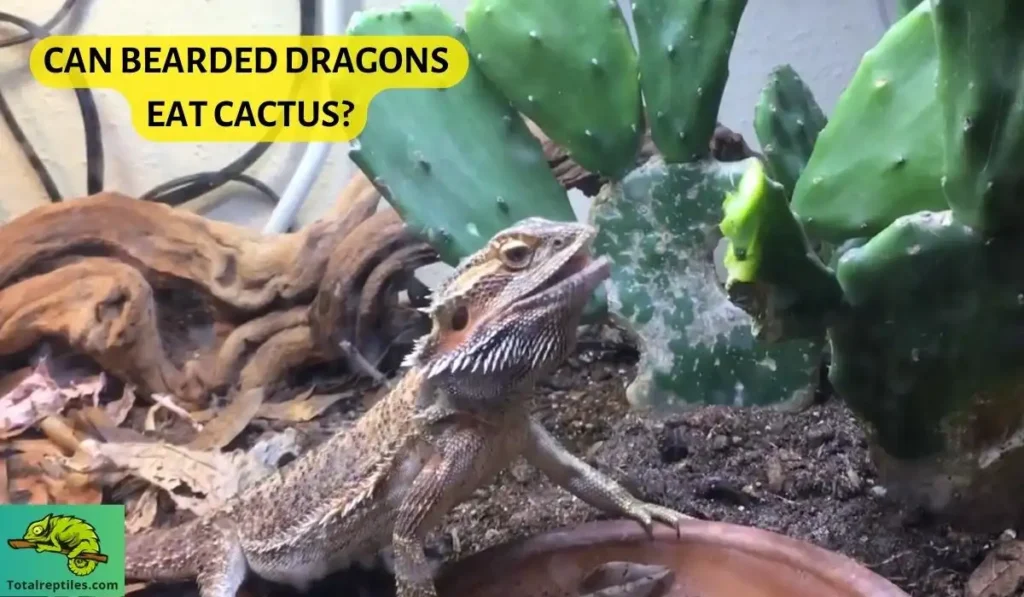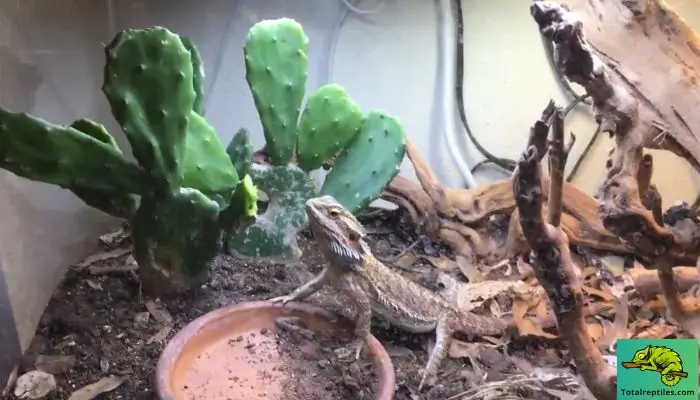Once the spines are removed, Cactus pads and Prickly Pear fruit are safe and healthy options to incorporate into your bearded dragon’s meals. They contain calcium, water, vitamins A, B6, C, thiamin, riboflavin, and calcium.
Bearded dragons and cacti might not seem like a natural pairing, but did you know these spiky plants can be a nutritious addition to your scaly friend’s diet?
To offer your bearded dragon a southwestern touch, consider offering cactus pads alongside leafy greens and other nourishing foods as part of their staple diet.

What Kind Of Cactus Can Bearded Dragons Eat?
Not all varieties are created equal when feeding cacti to your bearded dragon.
While certain cacti are safe and beneficial for these reptiles, others can harm their health. Here are a few cactus species that you can confidently offer to your lizard:
- Opuntia, or Prickly Pear Cactus, is one of the most popular cactus choices for bearded dragons.
Both the cactus pads and the fruit of the Prickly Pear are safe for consumption, provided that the spines and seeds are removed.
Prickly Pear cacti are rich in vitamins, minerals, and water, making them nutritious.
- Christmas Cactus: This cactus variety, also known as Schlumbergera, is non-toxic to bearded dragons and can be offered as an occasional treat.
But, Christmas Cactus should be fed in moderation due to its higher sugar content.
- Dragon Fruit Cactus: Dragon fruit, also known as Pitaya, is another safe option for bearded dragons. This tropical cactus offers a sweet and juicy treat for your pet.
Removing the skin and seeds before offering them to your dragon is essential.
Note: Always research and double-check the type of cactus you plan to feed your bearded dragon. Avoid any cacti with over thorns, spikes, or unknown toxicity.
Benefits of Feeding Cactus to Bearded Dragons
Here are some key advantages of incorporating cactus into your reptile’s meals:

1. Rich in Essential Nutrients:
- Cactus pads and Prickly Pear fruit are packed with essential vitamins and minerals, including vitamin A, vitamin B6, vitamin C, thiamin, riboflavin, calcium, and water.
- A bearded dragon’s body needs these nutrients to remain healthy, support its immune system, and develop properly.
| Nutritional Composition of Cactus | Benefits |
| Vitamin A | Supports vision, immune function, and growth. |
| Vitamin B6 | Important for metabolism and brain development. |
| Vitamin C | Boosts the immune system and acts as an antioxidant. |
| Thiamin | Supports the nervous system and energy production. |
| Riboflavin | Essential for energy production and overall health. |
| Calcium | Crucial for bone development and muscle function. |
| Water | Promotes hydration and aids in digestion. |
2. Hydration:
- Cactus has a high water content, which can help keep your bearded dragon well-hydrated. This is especially beneficial in warmer climates or during periods of increased activity when hydration is crucial.
- Including cactus in your dragon’s diet can supplement their water intake and increase their overall hydration levels.
3. Digestive Health:
- The fiber content in cactus can promote healthy digestion in bearded dragons.
- It aids in regulating bowel movements and preventing constipation, which is essential for maintaining a healthy gastrointestinal system.
4. Enrichment and Mental Stimulation:
- Offering cactus pads or Prickly Pear fruit as occasional treats can provide environmental enrichment for your bearded dragon.
- The different textures and tastes of cactus can stimulate their senses and add excitement to their feeding routine.
5. Dietary Variety:
- Adding cactus to your dragon’s diet expands its nutritional options and prevents monotony.
- By diversifying their meals, you can ensure that your bearded dragon receives a balanced and well-rounded diet, which contributes to their overall well-being.
Caution: While cactus can be beneficial, it should be fed in moderation. Excessive consumption of cactus can lead to watery stools or gastrointestinal upset. Below we cover some risk factors.
Risks And Concerns Associated With Cactus Consumption For bearded Dragons
Cactus can provide bearded dragons with several nutritional benefits, but there are also potential risks and concerns regarding their consumption. Here are some considerations:
- Spines and Prickles: Cactus plants are covered in spines or prickles that can cause injuries to your bearded dragon’s mouth, throat, or digestive tract if consumed without proper preparation. Always ensure that any spines are removed before offering cactus to your pet.
- Irritation and Allergies: Some bearded dragons may be sensitive or allergic to certain cactus varieties. Observing your dragon closely after introducing cactus to its diet is important.
In case of irritation, digestive upset, or allergic reactions, including swelling, rash, or difficulty breathing, discontinue feeding the cactus.
- Water Content: While the high water content of cactus can benefit hydration, excessive consumption can lead to watery stools or diarrhea. Moderation is vital to maintaining a healthy balance in your dragon’s diet.
- Chemical Treatments: Cacti grown for ornamental purposes may have been treated with chemicals or pesticides that can be harmful to bearded dragons.
It’s crucial to source cacti from trusted sources or consider growing them organically to avoid potential exposure to harmful substances.
- Variety and Balance: While cactus can be a nutritious addition to a bearded dragon’s diet, it should not replace other essential components.
Ensure their diet remains varied and balanced, incorporating other appropriate foods such as leafy greens, vegetables, and insects.
How to Prepare Cactus for Bearded Dragons
Preparing cactus for bearded dragons requires careful steps to ensure their safety and remove potential hazards. Here’s a guide on how to properly prepare cactus for your scaly friend:
Step-1: Choose the Right Cactus
Opt for safe varieties such as Prickly Pear cactus (Opuntia) or other known non-toxic species. Avoid cacti with spines, thorns, or unknown toxicity.
Step-2: Remove Spines and Prickles
Carefully remove the spines and prickles from the cactus pads or fruits using gloves and a pair of tongs. Trim off any remaining spines using a sharp knife or vegetable peeler.
Step-3: Peel the Skin
For cactus pads, peel off the outer skin using a knife or vegetable peeler. This helps remove any residual spines and tough outer layers.
Step-4: Remove Seeds
If feeding Prickly Pear fruit, cut it in half and scoop out the seeds using a spoon. Be sure to discard all seeds, as they can pose a choking hazard.
Step-5: Rinse Thoroughly
Rinse the cactus pads or fruit under cool running water to remove any remaining debris or sap.
Step-6: Cut into Bite-sized Pieces
Slice the prepared cactus pads or fruit into small, manageable pieces suitable for your bearded dragon’s size and feeding preferences.
Related FAQ’s
Q: Can bearded dragons eat cactus pads?
A: Yes, bearded dragons can eat cactus pads, like those from Prickly Pear cactus, as long as the spines are removed. Cactus pads offer nutritional benefits and can be included as part of their balanced diet.
Q: Can bearded dragons eat nopales?
A: Yes, bearded dragons can eat nopales, which are cactus pads commonly consumed by humans. However, ensure that the spines are removed, and feed them in moderation to maintain a balanced diet.
Q: Can bearded dragons eat jade plants?
A: No, bearded dragons should not eat jade plants (Crassula ovata) or any other succulents. These plants are toxic to them and can cause digestive problems or potential harm. It’s best to avoid feeding jade plants to your bearded dragon.
Final Words
So, now you know introducing cactus into your bearded dragon’s diet can provide a nutritious and exciting addition to their meals.
Just remember to remove spines, peel the skin, and feed in moderation. With proper preparation, cactus can be a prickly delight for your scaly companion.

